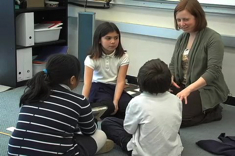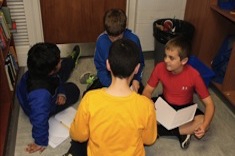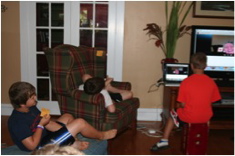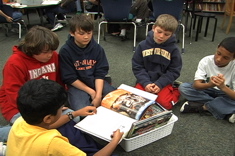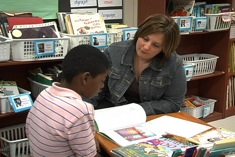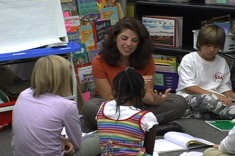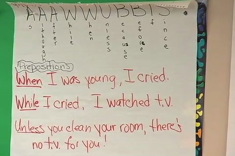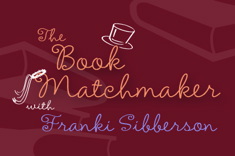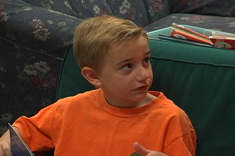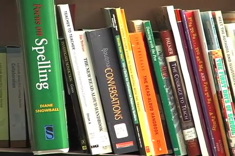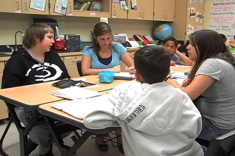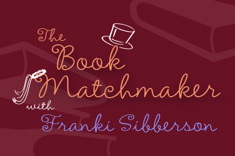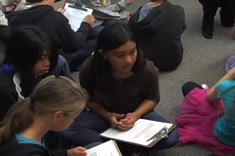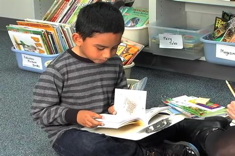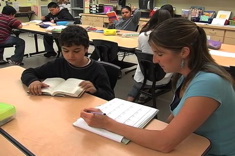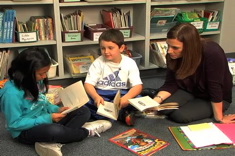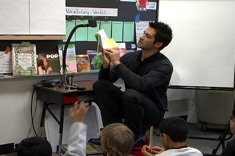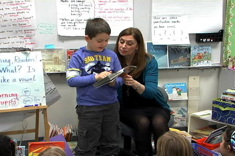Teaching Reading
Our contributors lead reading workshops in classrooms with creative flair. Over the past 12 years, we've filled our site with loads of suggestions, tools, and tips for using engaging books throughout the curriculum to hook kids on reading. Here is where you will find many stories of successful and not-so-successful workshop days, and what we learned from them. We bring these stories to life through hundreds of video examples.
Latest Content
Guiding Groups in Middle School: Reading Poetry
Katie Doherty works with a small group of sixth graders who need extra support as they read the poem “Aspects of Autumn.”
Worldwide Cinderellas
Erin Ocon discovers that worldwide Cinderella stories are a wonderful tool for building community and cultural awareness in her seventh-grade classroom and with English language learners. Erin describes how she uses a range of Cinderella picture books with students, and provides an extensive booklist for expanding your library.
Middle School Conferring About a Series
In this video from Katie Doherty’s sixth-grade classroom, Katie confers with a student who has returned to a series book she had previously rejected. Katie weaves in talk about strategies, particularly inferring (a focus of whole-class minilessons).
Book Club Meetings in 3rd Grade
Beth Lawson explains how she sets up book clubs in her 3rd grade classroom.
Book Matchmaker: Read Alouds for 1st Grade
Franki Sibberson helps a 1st grade teacher select read alouds for her class in this installment of Book Matchmaker.
What is the Content for Small-Group Instruction? (Part 2 of the Grouping Series)
Heather Rader considers how assessments and observations might be used to create flexible groups.
Accuracy and Comprehension: Conferring in Second Grade
In this video from Sean Moore’s second-grade classroom, Sean confers with a student who comprehends text well but has some issues with accuracy.
An At-Home Summer Reading Camp
Katherine Sokolowski comes up with a novel way to boost kids’ reading and her summer income —hosting a reading camp in her home.
Matching Students to Nonfiction Texts in Grades 3-6 (BOOKLIST)
In this booklist, Mary Lee Hahn offers creative categories for considering readers in new ways.
Next-Read Stack: Conferring for Independence
Franki Sibberson explains the value of "Next-Read Stack" conferences for fostering independence, and includes a video example.
The Five-Minute Solution: Mini-Groups after Minilessons to Maximize Conferring Time
Aimee’ Buckner’s mini-groups are an easy and simple way to differentiate instruction in workshops, and save time when conferring.
Getting Started with Sentence Observations
Karen Terlecky details the assessments and preparation that goes into the design of her sentence observation program.
Connecting Read Alouds and the Literacy Curriculum at the Start of the School Year
Here are some ways to link read alouds with learning across the curriculum at the start of the year, suggested by Choice Literacy readers.
Book Matchmaker: Texts for Young English Language Learners
Franki Sibberson shares some of her favorite new titles for young English language learners.
Fluency in Focus: Conferring with Jake
Gail Boushey confers with Jake, a seven-year-old who is setting a reading goal of developing fluency. After the conference, she debriefs with Joan Moser.
I Can’t Quite Put My Finger On It
Have you ever had a teacher enthusiastically embrace a new “magic bullet” instructional program that includes scripted or rote elements that concern you? Melanie Quinn considers this sticky situation instructional coaches sometimes find themselves in, and comes up with some starting points for conversations with colleagues.
Middle School Book Clubs in Action
Katie Doherty talks about the links between strategy lessons and book club work in her 6th grade classroom. Katie also sits in on a book club discussion.
Book Matchmaker: “Cool” Books for a Struggling Second Grader
Franki Sibberson selects some “cool” books for a struggling reader who wants to fit in with his 2nd grade peers.
The Sponge Summary Lesson Part 5
In this sequence of videos, Heather teaches a 4th grade class, using the analogy of a sponge to explain how summaries work. In this fifth video, Heather and students shift from “I do” to “we do” as students try test their summary writing skills with partners
Tried and True Trumps Shiny and New
Amanda Adrian explains why running records are still an essential tool in any teacher’s assessment arsenal. She also includes links to web resources for honing your running record skills if they are a bit rusty.
Words and Images: Mentor Texts for Second Grade Boys
In this conference with two of her second-grade students, Linda Karamatic shares mentor texts and tips to help them with their writing. Both boys are writing stories with strong visual components.
The Sponge Summary Lesson Part 6
In this sequence of videos, Heather teaches a 4th grade class, using the analogy of a sponge to explain how summaries work. In this final video, Heather and students debrief and capture their learning in writing.
Conferring with Tweens: Boys and Series Books
In this conference from a 6th grade classroom, Katie Doherty confers with a boy who is reading a book from a series she is unfamiliar with – watch how she engages the child to learn about the series and refocus the discussion on skills and goals.
Guiding Reading Partners: Work on Accuracy
In this reading conference from a 2nd grade classroom, Linda Karamatic pairs two children who have similar needs in reading.
Frogs as Learning Ambassadors Part 1: Literary Nonfiction in 4th Grade
Andrea Smith gets creative in teaching literary nonfiction to her 4th graders in this video series.
Rumor Has It
Lisa Koch says we should get our students to start some rumors — about characters, that is.
Narrative Nonfiction in 5th Grade Part 2
In this lesson from a 5th grade classroom, Aimee Buckner guides students in a note-taking process to help understand the qualities of nonfiction narrative writing. In this second part of the lesson, students share their notes and Aimee makes connections to additional mentor texts.
Nonfiction Read Aloud
Sean Moore reads nonfiction aloud to his 2nd grade students. This is the first video in a two-part series.
Nonfiction Read Aloud – Part 2
Here are some more tips for nonfiction read-alouds, based on Sean Moore's reading of Plants That Eat Animals.
Astrigs, Asterisks, and Letting Students Lead
In this video from Linda Karamatic’s second-grade classroom, Charlie shares his punctuation “find” of asterisks with his classmates. He is reading the book Miss Child Has Gone Wild by Dan Gutman.
Browse Content By
Type
Category
- Assessment Tools
- Big Fresh Archives
- Booklists
- Choice Numeracy
- Classroom Design
- Common Core
- Community Building
- Conferring
- Content Literacy
- Digital Literacy
- English Language Learners
- Equity
- Family Relations
- Free Samples
- Guiding Groups
- Leadership
- Literacy Coaches
- Mentor Texts
- Minilessons
- New Teacher Mentors
- Podcasts
- Poetry
- Quote Collections
- Reading Strategies
- Self Care
- Struggling and Striving Learners
- Talking and Listening
- Teacher Study Groups
- Teaching Reading
- Teaching Writing
- Word Study and Vocabulary
Author
- Melissa Quimby
- Nawal Qarooni
- Gwen Blumberg
- Julie Cox
- The Lead Learners
- Hannah Tills
- Josie Stewart
- Ruth Metcalfe
- Mallory Messenger
- Becca Burk
- Jodie Bailey
- Vivian Chen
- Mary Brower
- Tiffany Abbott Fuller
- Stephanie Affinito
- Ruth Ayres
- Leigh Anne Eck
- Heather Fisher
- Shari Frost
- Julie Johnson
- Suzy Kaback
- Gigi McAllister
- Shirl McPhillips
- Melanie Meehan
- Cathy Mere
- Debbie Miller
- Tara Barnett and Kate Mills
- Tammy Mulligan
- Dana Murphy
- Bitsy Parks
- David Pittman
- Brenda Power
- Heather Rader
- Matt Renwick
- Mandy Robek
- Christy Rush-Levine
- Gretchen Schroeder
- Jen Schwanke
- Brian Sepe
- Katherine Sokolowski
- Stella Villalba
- Jennifer Vincent
Grade Level
Choice Literacy Membership
Articles
Get full access to all Choice Literacy article content
Videos
Get full access to all Choice Literacy video content
Courses
Access Choice Literacy course curriculum and training




